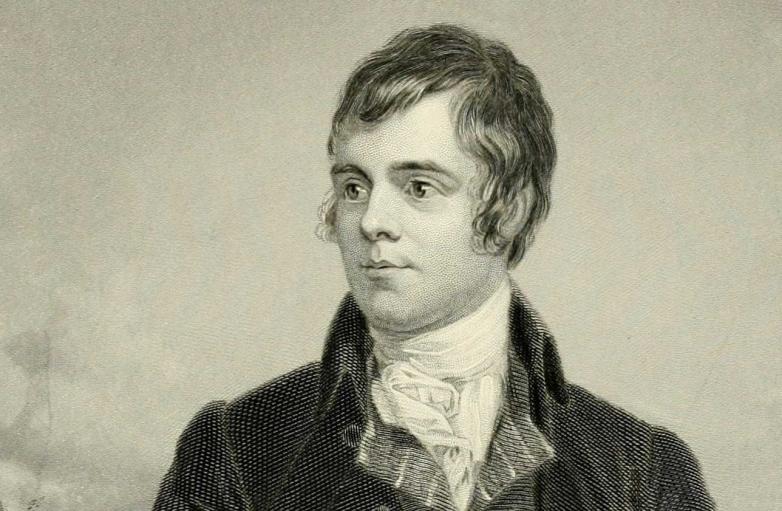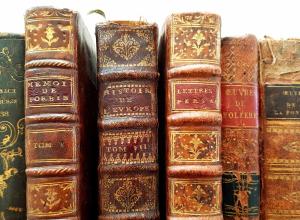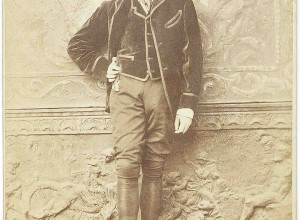Robert Burns and “Auld Lang Syne” at the Morgan Library

Robert Burns
New York, NY, November 22, 2011—Each New Year's Eve, millions raise their voices in a chorus of "Auld Lang Syne," standing with friends and looking back with nostalgia on days past. But how did a traditional Scots folk song—with lyrics that many people scarcely understand—emerge as one of the world's most enduring popular songs? It was Robert Burns (1759-1796), the great eighteenth-century Scottish poet, who transformed the old verses into the version we know today. Robert Burns and "Auld Lang Syne" at The Morgan Library & Museum untangles the complex origins of the song that has become, over time, a globally shared expression of friendship and longing. On view from December 14, 2011 through February 5, 2012, the exhibition features rare printed editions, a manuscript of the song in the poet's own hand, and selections from the Morgan's important collection of Burns letters—the largest in the world.
The Scots words for "old," "long," and "since" combine to form a phrase that translates loosely as "time gone by," "old time's sake," or, in some contexts, "once upon a time." But the old Scots phrase so gracefully evokes a sense of nostalgia that it has been embraced throughout the English-speaking world. Burns, who reworked the song for publication, declared that "a sprinkling of the old Scotish has an inimitable effect." While the song has become indelibly associated with New Year's Eve, it remains an anthem of friendship and remembrance.
"There are some works of art that have become so much a part of our collective consciousness that we forget that they did not emerge fully formed," said Christine Nelson, the Morgan's Drue Heinz Curator of Literary and Historical Manuscripts and Head of Interpretive Strategy. "'Auld Lang Syne' is just such a work. We are pleased to be able to look back at the early history of this familiar song by presenting selections from two of the Morgan's great collections: the Robert Burns letters and manuscripts purchased by Pierpont Morgan in 1906, and the recently acquired James Fuld Collection of printed music."
Exhibition highlights
Like many traditional songs, "Auld Lang Syne" has a tangled history. The words and melody we sing today have roots in an old Scottish ballad and dance tune, but went through various incarnations before finally coming together in 1799 in A Select Collection of Original Scotish Airs for the Voice. This important edition, published by George Thomson with major contributions by Robert Burns, is on view along with earlier volumes that trace the evolution of what has become one of the world's most popular songs.
The centerpiece of the exhibition is a celebrated letter that Burns wrote to Thomson in 1793, filling page after page with comments on some seventy-four traditional songs. "One song more," Burns told Thomson, "& I have done. Auld lang syne—the air is but mediocre; but the following song, the old song of the olden times, & which has never been in print, nor even in manuscript, untill I took it down from an old man's singing; is enough to recommend any air." Burns then wrote the now-famous words in his own hand.
In another important letter on view, written in 1788 to his friend Frances Dunlop, Burns made his first documented reference to the song. Mrs. Dunlop had recently seen a dear friend after a long separation. "We met as we parted after an interval of forty-five years," she told Burns. He replied with these lines: "Apropos, is not the Scots phrase, 'Auld lang syne,' exceedingly expressive. There is an old song & tune which has often thrilled thro' my soul." Over two hundred years later, we still associate the song with old friends and bittersweet nostalgia.
Though Burns preferred to minimize his contribution and claim that he did nothing more than copy a traditional song, even George Thomson, who was the first to publish "Auld Lang Syne" as we know it, felt that "the Song affords evidence of our Bard himself being the author." Indeed, Burns devoted the last ten years of his short life to collecting old verses for publication in two major compilations of Scottish song, and he freely revised and "mended" as he saw fit, even composing new poetry to accompany traditional tunes.
The exhibition presents versions of "Auld Lang Syne" that predate the Burns version. On view, for example, is what is believed to be the earliest surviving manuscript rendering of a ballad beginning Should old acquaintance be forgot, written in a nobleman's commonplace book from the 1660s. The "old acquaintance" of this ballad is a faithless lover ("the most disloyall maid that ever my eye hath seen") rather than a beloved old friend. Though the first line is familiar, the rest of the text bears little resemblance to the enduring version that Burns gave us over a century later.
The tune we now call "Auld Lang Syne," too, has a complex history. On view is a mid-eighteenth-century compilation that includes "The Miller's Wedding," a strathspey (a type of Scottish dance) that includes a hint of the tune we now call "Auld Lang Syne." In 1792, James Johnson published the now-familiar tune in his collection The Scots Musical Museum—but it accompanied the words of a song called "O Can Ye Labor Lea, Young Man," not "Auld Lang Syne." In fact, when the Burns version of "Auld Lang Syne" was published for the first time in 1796, in a later volume of the Museum, the words were paired with an altogether different tune.
It was George Thomson who first brought the words and music together in his Select Collection of Original Scotish Airs in 1799, after Burns's death. It was not unusual to pair verses with whatever popular tune provided a good metrical fit, so it was simple for Thomson to make the switch. Burns was not Thomson's only prominent collaborator; Thomson also engaged such prominent composers as Joseph Haydn and Ludwig van Beethoven to compose new musical settings of Scottish songs for voice, piano, violin, and cello. The exhibition features an important manuscript, in Beethoven's own hand, of three of the settings that Thomson commissioned from the great German composer over the course of about a decade. Beethoven would later supply Thomson with a new setting for "Auld Lang Syne."
Since his death in 1796, Burns has remained wildly popular, and countless literary pilgrims have made their way to southwestern Scotland to pay him tribute. The exhibition includes, for example, a handful of pressed wildflowers gathered by American author Nathaniel Hawthorne during an 1857 visit, as well as a charming letter that John Keats wrote to his teenage sister during the 1818 trip that inspired his sonnet "On Visiting the Tomb of Burns." The original handwritten journal of the great Scottish poet and novelist Sir Walter Scott is shown open to this heartfelt tribute: "Long life to thy fame and peace to thy soul, Rob Burns. When I want to express a sentiment which I feel strongly, I find the phrase in Shakespeare or thee." And a copy of the 1787 edition of Burns's poems, lavishly rebound during the twentieth century and incorporating a bejeweled portrait of the author, is shown as a more recent example of "bardolotry."
Multimedia
The exhibition includes an audio guide (accessible on complimentary listening devices available at the Morgan's information desk) that allows visitors to listen along as they look at rare printed musical scores that trace the evolution of the tune of "Auld Lang Syne." An online multimedia exhibition features a dozen printed editions and manuscripts, allowing web visitors to follow the early history of both the words and music of the song.
"Auld Lang Syne" in popular culture
During the 1920s and 1930s, the great bandleader Guy Lombardo adopted "Auld Lang Syne" as his signature song. Since then, many popular films that have featured the song at key moments in the action. In Frank Capra's classic It's a Wonderful Life (1946), George Bailey's brother memorably leads friends, family, and neighbors in the song to mark the moment when George (Jimmy Stewart) reclaims his appreciation for life. In Waterloo Bridge (1940), the glamorous Vivien Leigh and Robert Taylor dance by candlelight to a wordless version of the song. In Rob Reiner's When Harry Met Sally (1989), two good friends admit their love for each other as strains of the song play at the culmination of a New Year's Eve party. When Harry (Billy Crystal) wonders what the song means, Sally (Meg Ryan) declares, simply, "It's about old friends," echoing Robert Burns's famous letter to Frances Dunlop, which is on view in the exhibition. And in the 2008 film Sex and the City, Mairi Campbell and Dave Francis of The Cast perform the song as it was first published in 1796—with Burns's words set to a now unfamiliar tune.
The Morgan's Scottish holdings
The Morgan Library & Museum is the most important repository of Scottish literary manuscripts and letters outside of Scotland. Holdings include a manuscript of The Strange Case of Dr. Jekyll and Mr. Hyde in the hand of Robert Louis Stevenson; half the surviving manuscripts of the novels of Sir Walter Scott (including Ivanhoe and Guy Mannering) as well as the whole of his personal journal; and over 120 letters of Robert Burns which incorporate manuscripts of at least one hundred poems. The Morgan's Burns collection includes the two principle series of his surviving letters: those to the music seller and editor George Thomson, and those to Frances Anna Dunlop, a widow with whom Burns enjoyed a long correspondence.
The James Fuld Music Collection
In 2008 the Morgan purchased the James Fuld Collection, considered to be the finest private collection of printed music in the world. It includes thousands of first editions of classical and popular music from the eighteenth century to the present by American and European composers, in addition to legendary rarities such as the first issue of "The Star Spangled Banner." Mr. Fuld had a particular fondness for "Auld Lang Syne" and collected important early editions of the work as well as precursors to the song as we know it today.
Organization and Sponsorship
This exhibition was made possible by a generous gift in honor of Mr. Thomas Burns Reid and Mrs. Mary Theresa Reid. Robert Burns and "Auld Lang Syne" is organized by Christine Nelson, the Morgan's Drue Heinz Curator of Literary and Historical Manuscripts and Head of Interpretive Strategy.
The Morgan exhibition program is supported, in part, by public funds from the New York State Council on the Arts and the New York City Department of Cultural Affairs.
"Auld Lang Syne"
The Burns version,
from the Morgan manuscript
Should auld acquaintance be forgot,
And never brought to mind?
Should auld acquaintance be forgot,
And days o' lang syne!
For auld lang syne, my Dear,
For auld lang syne,
We'll tak a cup o' kindness yet,
For auld lang syne.
We twa hae run about the braes,
And pu't the gowans fine;
But we've wander'd mony a weary foot,
Sin auld lang syne.
We twa hae paidlet i' the burn,
Frae mornin' sun till dine:
But seas between us braid hae roar'd,
Sin auld lang syne.
And there's a hand, my trusty feire,
And gie's a hand o' thine;
And we'll tak a right gude-willie waught,
For auld lang syne.
And surely ye'll be your pint-stowp,
And surely I'll be mine;
And we'll tak a cup o' kindness yet,
For auld lang syne.
The Burns version,
with Scots words translated
Should auld acquaintance be forgot,
And never brought to mind?
Should auld acquaintance be forgot,
And days o' lang syne!
For auld lang syne, my Dear,
For auld lang syne,
We'll take a cup o' kindness yet,
For auld lang syne.
We two have run about the hills,
And pulled the daisies fine;
But we've wander'd many a weary foot,
Since auld lang syne.
We two have paddled in the brook,
From mornin' sun till dinnertime:
But seas between us broad have roar'd,
Since auld lang syne.
And there's a hand, my trusty friend,
And give us a hand o' thine;
And we'll take a right goodwill draft,
For auld lang syne.
And surely ye'll buy your pint-cup,
And surely I'll buy mine;
And we'll take a cup o' kindness yet,
For auld lang syne.















